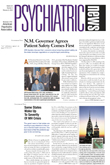The government needs to be a smarter consumer if it wants to rein in Medicare spending, according to two recent studies.
Both studies appeared in the December 4, 2003, Health Affairs.
In one study, Steve Lieberman, Ph.D., assistant director of the Health and Human Resources Division at the Congressional Budget Office, and colleagues suggested that the Medicare program should focus strategies for improving cost efficiency on those beneficiaries who consume the largest amount of health care resources.
They compared two alternative approaches for lowering the growth of Medicare spending.
The first approach is to focus on high-cost individuals to make health care for the sickest beneficiaries more efficient, possibly through techniques like disease management. A second approach, advocated by some health policy experts, is to focus on high-spending regions to change practice patterns, reducing ineffective and “supply-sensitive” health care treatment—that is, those procedures that vary in frequency based on the number of providers in an area.
Based on an analysis of spending data, Lieberman and colleagues found that focusing on high-cost beneficiaries who typically have multiple chronic conditions has more potential to control health care cost growth.
“Medicare spending is extremely concentrated among a very small group of people,” Lieberman said in a Webcast interview about the study. “Five percent of the beneficiaries, who are the most expensive 5 percent, cost as much as the remaining 95 percent of the beneficiaries.”
Conversely, he said, the 40 percent of the Medicare population that is the least costly to care for account for only about 1 percent of Medicare spending—an average of less than $200 per person per year.
“So they are essentially not quite free, but pretty close to it, and there isn’t much savings that would appear to be picked up by focusing on these people,” Lieberman said.
Lieberman and colleagues found that if Medicare focuses on reducing spending for the costliest 1 percent of beneficiaries, it would be getting at about 17 percent of total spending. Conversely, if Medicare focuses on the costliest Hospital Referral Regions, in which 1 percent of beneficiaries live, those beneficiaries represent only 1.2 percent of total Medicare spending.
“From a budgetary perspective, a strategy centered on high-cost individuals could hold the promise of greater ‘bang for the buck,’ ” Lieberman and his colleagues said. “Simply, there’s more money concentrated in fewer individuals.”
In an accompanying article, Robert Berenson, Ph.D., a senior fellow at the Urban Institute, proposed transforming Medicare from a payer of claims to a “strategic purchaser”—basically, a smart consumer—that seeks out high quality and acceptable cost.
As a strategic purchaser, Medicare would identify beneficiaries who could benefit from disease management, recalibrate hospital payments more frequently to avoid market distortions that increase Medicare costs, and offer bonuses to hospitals that achieve quality goals.
During the Webcast interview, Berenson cited a recent controversial decision by the government to approve intracardiac defibrillators for a larger population of Medicare patients.
But he noted that there is in fact evidence that “these defibrillators are often put into people who really won’t benefit from them, and in a sense aren’t allowed to die a natural death.”
He added, “But this defibrillator is keeping them alive, and they die of dementia or something more painful.”
Berenson said, “Why not say, ‘Let’s approve these defibrillators but let’s identify centers of excellence as the places where beneficiaries go to get true informed consent about whether this is in their best interest.’ ” In this way, he said, the government would be managing how it purchases expensive health care services.
